Android Central Verdict
The Galaxy A53 5G is faster than its predecessor, has a larger battery, takes better photos, and will get more software updates than any other mid-range phone. It doesn't have a 3.5mm jack or a charger in the box, but the upside is that it costs $450 — $50 less than the A52. This is the mid-range phone to beat right now.
Pros
- +
Vibrant 120Hz AMOLED screen
- +
Decent hardware
- +
64MP camera takes good photos
- +
Battery lasts over a day
- +
Four guaranteed Android OS updates
- +
IP67 dust and water resistance
Cons
- -
No 3.5mm jack
- -
No Wi-Fi 6 connectivity
- -
Not designed for intensive gaming
- -
No bundled charger
Why you can trust Android Central
Samsung is increasingly focusing on the Galaxy A series, and for good reason. The series accounted for nearly two-thirds of Samsung's global sales last year, and that number is only set to increase as more and more customers shift to affordable 5G-enabled phones.
The Galaxy A52 stood out for its value, long-term software updates, and reliable hardware, and Samsung is building on that in 2022 with the Galaxy A53. The phone doesn't differ too much from its predecessor, with Samsung instead focusing on a few areas. The key changes include a larger 5000mAh battery that lasts well over a day, updated internal hardware that's more energy-efficient, and the promise of longer updates.
That said, it misses out in a few areas: there's no 3.5mm jack or a bundled charger this time. Samsung is instead betting on the $450 price point — $50 less than its predecessor — as a key selling point, so let's see what the Galaxy A53 has to offer, and if you should consider the phone if you're looking for an upgrade in 2022.
Samsung Galaxy A53 5G: Pricing and availability
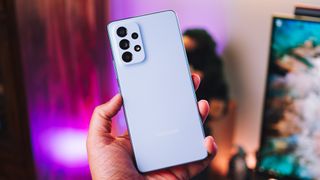
Samsung unveiled the Galaxy A53 5G on March 17, and the phone is now up for pre-order in global markets. Unlike last year — where we had 4G and 5G versions of the Galaxy A52 — the Galaxy A53 is available in a single option globally, and it comes with 5G connectivity as standard.
The Galaxy A53 costs $450 in the U.S. and £399 ($525) in the U.K., with pre-orders in both regions netting a free Galaxy Buds Live. Samsung has trade-in offers in North America and the U.K. that go up to $205 for trading in your current phone. The Galaxy A53 will hit store shelves starting April 1.
Over in India, the Galaxy A53 is available in two configurations, with the 6GB/128GB model debuting at ₹34,499 ($452) and the 8GB/128GB version coming in at ₹35,999 ($472). While that's on par with what the phone retails for in the U.S., it is considerably costlier than the ₹26,499 ($348) that the A52 debuted at last year. However, the A52 was a 4G-only device, and the A53 has the requisite 5G bands for India.
Samsung Galaxy A53 5G: Design
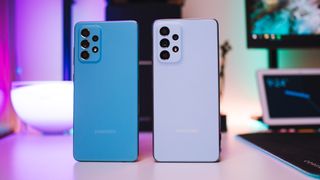
Last year, Samsung introduced a new design aesthetic on the Galaxy A52 that included a rectangular chassis with flat sides and pastel colors. This year, the Korean brand isn't making any broad changes, with the Galaxy A53 retaining the same design albeit with a few tweaks.
The flat sides and boxy design means the Galaxy A53 isn't as comfortable to use as the A52.
The sides are now fully flat with no curves at the front or back, and the camera island has a seamless design that looks like it's emerging naturally from the chassis. While it isn't as dramatic as the Find X5 Pro, it looks good nevertheless.
Samsung is once again offering a polycarbonate back with a matte finish that feels great to touch, and it has an added bonus of preventing smudges.
The key design change is around the mid-frame, where Samsung is going with a glossy finish decked out in chrome. The Galaxy A52 also had the same finish, but the sides were coated the same color as the back, giving the design a more cohesive look.






The chrome sides make the Galaxy A53 look a little tacky, but my biggest issue with the design is the flat sides; I'm not a fan of this aesthetic, and the lack of any curves means the A53 isn't as comfortable to hold and use even though it is 0.3mm thinner than the A52. You'll definitely want to invest in a case if you're interested in the A53.
Other than that, the basics are unchanged here; you'll find the power and volume buttons on the right, and there's a SIM card tray that holds either two SIM cards or a SIM alongside a microSD card.
The buttons and SIM tray are made out of recycled post-consumer materials, and they're not as tactile as the ones on the A52.
Samsung Galaxy A53 5G: Screen
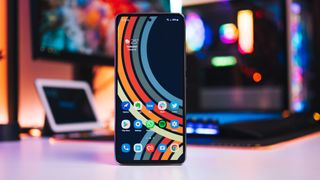
There really isn't a whole lot to talk about with the screen. The Galaxy A53 has the same 6.5-inch AMOLED screen as last year's A52 5G, and it goes up to 120Hz. The max brightness is also unchanged at 800 nits, and it gets sufficiently bright outdoors that it wasn't an issue for me. And covering the screen is a layer of Gorilla Glass 5.
While the screen misses out on some of the niceties that you'll find on the Galaxy S22 Ultra — like HDR10+ and dynamic scaling — it excels at the basics. You get vibrant colors, the 120Hz mode is enabled out of the box, you can tweak the color balance to your tastes, the always-on mode has a lot of configurability, and you get schedulable dark mode.
With the A53 featuring a thinner chassis, there's no 3.5mm jack on the device. That said, you get decent stereo sound, and that makes watching videos and playing games a little more immersive.
Samsung Galaxy A53 5G: Performance
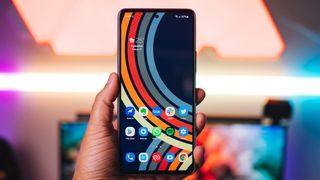
While Samsung is using Qualcomm-based hardware in more parts of the world this year, that's limited to the Galaxy S22 series. In an interesting move, the Galaxy A53 comes with the Exynos 1280 as the default option globally, including in North America.
The Exynos 1280 includes two Cortex A78 cores that hit 2.40GHz alongside six Cortex A55 cores at 2.0GHz and a Mali-G68. It is a 5nm part, and the node shrink over last year's 8nm Snapdragon 720G/750G means the A53 is that much more efficient. Add in a bigger 5000mAh battery, and you'll see noticeable gains in day-to-day use.
| Category | Samsung Galaxy A53 5G |
|---|---|
| Operating system | Android 12 |
| Row 1 - Cell 0 | One UI 4.1 |
| Display | 6.5-inch 120Hz AMOLED |
| Row 3 - Cell 0 | 2400x1080 (20:9) |
| Row 4 - Cell 0 | Gorilla Glass 5 |
| Chipset | Exynos 1280 |
| Row 6 - Cell 0 | 2 x 2.40GHz Cortex A78 |
| Row 7 - Cell 0 | 6 x 2.0GHz Cortex A55 |
| Row 8 - Cell 0 | Mali-G68, 5nm |
| RAM | 6GB/8GB |
| Storage | 128GB/256GB |
| MicroSD slot | Yes |
| Rear camera 1 | 64MP f/1.8 |
| Row 13 - Cell 0 | 0.8um pixels, PDAF, OIS |
| Row 14 - Cell 0 | 4K at 30fps |
| Rear camera 2 | 12MP f/2.2 wide-angle |
| Row 16 - Cell 0 | 1.12um pixels, 123-degree FoV |
| Rear camera 3 | 5MP f/2.4 macro |
| Rear camera 4 | 5MP f/2.4 portrait |
| Front camera | 32MP f/2.2 |
| Row 20 - Cell 0 | Fixed focus |
| Row 21 - Cell 0 | 4K at 30fps |
| Connectivity | 5G Sub-6, Wi-Fi ac |
| Row 23 - Cell 0 | Bluetooth 5.1, NFC |
| Audio | USB-C, stereo speakers |
| Battery | 5000mAh |
| Charging | USB-C 2.0 |
| Row 27 - Cell 0 | 25W wired charging |
| Water resistance | IP67 |
| Security | In-display reader (optical) |
| Colors | Black, White, Blue |
| Dimensions | 159.6 x 74.8 x 8.1mm 189g |
| Price | $450 (U.S.), £399 (UK), ₹34,499 (India) |
I don't give a lot of weight to synthetic benchmark scores, but given that the Exynos 1280 is an unknown quantity, I put the Galaxy A53 to the test.
I pitted the A53 against the Galaxy A52 to get an overview of how the hardware has evolved over the course of a year, and the Nord 2 to get a sense of how it holds up for gaming. The Dimensity 1200-powered Nord 2 is one of the best mid-range phones for gaming, so it makes sense to take a look at how the Galaxy A53 fares in this regard.
| Category | Galaxy A52 | Galaxy A53 | OnePlus Nord 2 |
|---|---|---|---|
| CrossMark (Overall) | 438 | 510 | 645 |
| Productivity | 452 | 551 | 653 |
| Creativity | 437 | 472 | 664 |
| Responsiveness | 400 | 533 | 570 |
| Geekbench 5.1 (single-core) | 559 | 743 | 803 |
| Geekbench 5.1 (multi-core) | 1703 | 1929 | 2405 |
| 3DMark Wild Life (score) | 1044 | 2335 | 4227 |
| 3DMark Wild Life (FPS) | 6.25 | 14.02 | 25.3 |
| 3DMark Wild Life Extreme (score) | 316 | 642 | 1294 |
| 3DMark Wild Life Extreme (FPS) | 1.9 | 3.8 | 7.75 |
Right off the bat, it's evident that the Galaxy A53 is significantly more powerful than its predecessor. By using a similar set of Arm cores as the Dimensity 1200 (albeit clocked lower), the A53 is able to hold its own against the Nord 2.
The Mali-G68 GPU also fares well against the A52, with the A53 delivering a 2x increase across the board. It's still not quite on par with the Nord 2, but that's because the Dimensity 1200 is a gaming powerhouse. For context, the Pixel 5a — the Galaxy A53's immediate rival — scores lower in all 3DMark tests.
The Galaxy A53 is faster than its predecessor, but it isn't designed for intensive gaming sessions.
As for real-world usage, the Exynos 1280 holds its own for most daily tasks, including Chrome browsing, scrolling through Twitter and Instagram, and playing the occasional game. However, this isn't a chipset built for intensive gaming, and that's noticeable in games like Call of Duty: Mobile or PUBG Mobile. Both games go down to medium settings, and there is an occasional jitter while playing.
Furthermore, there is an infinitesimal lag when navigating the UI, particularly when launching or closing an app — it's almost as if the chipset can't keep up with the 120Hz panel. Of course, this could just be a case of Samsung not optimizing the Exynos 1280 for the screen, and given the potential of the hardware, the A53 isn't as fluid as it should be.
The Galaxy A53 comes with 6GB of RAM with 128GB of storage as standard, and you'll also find a version with 8GB of RAM and 128GB of storage in select global markets.
With Samsung essentially reusing most of the same parts as last year, the phone misses out on Wi-Fi 6 connectivity. You get Bluetooth 5.1, NFC, and the usual set of sensors, but for a mid-range phone in 2022 to not have Wi-Fi 6 is a glaring omission.
Samsung offers Sub-6 5G connectivity for the global variants of the Galaxy A53, with 5G bands changing based on the region. The rest of the features are unchanged from last year; you get an optical in-screen reader that's accurate (if a bit slow at times), and the vibration motor is quite good for this category. It doesn't quite manage to deliver detailed feedback like the one on the Galaxy S22 Ultra, but it is a decent option nonetheless.
Samsung Galaxy A53 5G: Battery
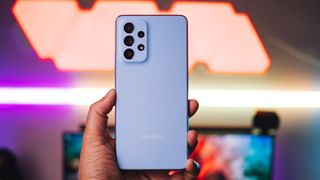
As for the battery, the 5000mAh unit ensures the Galaxy A53 lasts over a day even with heavy use. I got well over 5.5 hours of use over the course of 18 hours, and the battery never went below 20%.
The phone retains the same 25W fast charging standard as the A52, with a full charge taking over 80 minutes — significantly more than its rivals. However, with the likes of Xiaomi now offering 120W charging tech in this category and Realme standardizing 65W charging, Samsung isn't anywhere close to the lead here.
Battery life is noticeably better than last year, but there's no charger in the box this time.
That said, it takes just over 30 minutes to hit a 50% charge on the A53, and the relatively modest charging tech should deliver better battery longevity. What's more annoying is the fact that you don't get a charger in the box with the A53.
This wasn't the case last year, and Samsung's decision not to include any accessories in the box is a bit of a letdown. I understand the brand not wanting to bundle a charger on its flagship phones, but it makes no sense here.
Rounding out the battery side of things, the Galaxy A53 lacks wireless charging. It isn't astonishing, considering we haven't seen many mid-range phones feature a Qi coil at the back, so you're limited to plugging in the device to charge it up.
Samsung Galaxy A53 5G: Cameras

Samsung is using a familiar quad-camera array at the back that includes a 64MP primary lens with OIS, a 12MP wide-angle lens with a 123-degree field of view, and dual 5MP macro and portrait lenses. In addition, there's a 32MP camera at the front with a fixed-focus lens, and it can shoot 4K video at up to 30fps — the same as last year.
While the camera configuration hasn't changed, Samsung notes that it is using new sensors on the Galaxy A53. The new hardware, combined with the software algorithm tweaks that Samsung introduced with One UI 4.1, makes the A53 stand out from its predecessor.
The camera interface itself hasn't changed all that much — if you're coming from another Galaxy phone, you will find the UI to be very familiar. All the shooting modes are easily accessible, you get toggles for HDR, timer, flash, and filters, and you can easily switch between the various lenses.







The Galaxy A53 does a great job in daylight situations, delivering images with excellent dynamic range, color vibrancy, and contrast levels. There's minimal noise in daylight shots, and as is the case with all Samsung phones, colors tend to be oversaturated.
But what makes the A53 stand out is its low-light prowess; the phone does a much better job than its predecessor in this area. There are instances where you miss out on finer details as the highlights and shadows are turned down to minimize noise levels, but on the whole, the phone holds its own in this category.
The dedicated night mode does a great job bringing out details in scenes with little to no lighting, but the downside is that it is limited to the primary lens — it doesn't work on the wide-angle module.
On that note, the 12MP wide-angle lens isn't quite as good as the 64MP primary shooter. There's lens distortion at the edges, it doesn't produce the same color balance, and the shots are lacking in detail. The lens struggles to take photos in low light, and the lack of a night mode means you'll be limited to the primary lens.
Similarly, the 5MP macro lens is present only to round out the specs sheet; it doesn't offer anything meaningful here.
Overall, the Galaxy A53 does a great job in this category. It isn't as effortless to shoot as the Pixel 5a — there are a few issues with focusing and dialing in on a subject — it is better than what we got last year.
Samsung Galaxy A53 5G: Software
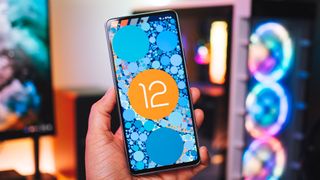
On the software front, the Galaxy A53 comes with One UI 4.1 based on Android 12 out of the box. Samsung recently announced that it would deliver four Android OS updates to its flagships and mid-range phones, and the Galaxy A53 is included in the list. That means that the phone will get the Android 16 update once it is available sometime in 2025.
Make no mistake here — the Galaxy A53 will get more software updates than any other mid-range phone.
That gives the Galaxy A53 an unassailable advantage in the mid-range category. There really isn't another device that will get anywhere close to the same number of updates as the A53, and it's clear that Samsung is betting on long-term updates as a differentiator.
As for the interface itself, One UI 4.1 doesn't deviate too much from a visual point of view, with Samsung instead focusing on adding all the features Google introduced in Android 12.
There's a color picker mode that lets you select accent colors based on the current background, recording indicators when the camera or mic are in use, and a privacy dashboard that lets you see what data is being accessed by services in the background.
In short, you'll feel immediately familiar with One UI 4.1 if you're coming from an older Samsung phone. Samsung's dialer and messages are set as default out of the box, but you now have the ability to switch to Google's options.
Every other Android manufacturer has switched to Google's phone dialer and Android Messages as standard with Android 11, and while Samsung isn't quite following suit, there is at least the option of using Google's alternatives here.
The biggest downside on the software front is the bloatware — you'll find a lot of it here.
While Samsung has many features to offer with One UI 4.1, there are a few annoyances. It feels like the Korean brand was intent on adding as much bloatware as possible on the device, and as a result, you'll need to pay particular attention while setting up the phone lest you install even more crud that you won't use.
The bloatware varies by region, and while it can be uninstalled or disabled, Samsung really needs to do better here.
On that note, One UI 4.1 continues to serve ads, mostly from the Galaxy Store and Samsung's stock apps. As soon as I set up the phone, I got an ad for the Galaxy Z Fold 3, and I don't understand the logic behind serving ads for other phones to customers who just bought a device. This is another area that Samsung needs to address because the ads detract from what is an otherwise excellent interface.
Samsung Galaxy A53 5G: The competition

The mid-range segment has a lot of interesting options at the moment, and Google's Pixel 5a is an obvious choice if you're interested in a new phone in 2022. The Pixel 5a has an OLED panel, and while it misses out on a high refresh rate screen, it wins in other areas. The cameras, in particular, are fantastic, with the phone able to deliver flagship-class photos.
The Snapdragon 765G is showing its age, though, and the Pixel 5a isn't quite as fast as the A53. That said, the 4680mAh battery ensures the phone lasts over a day with ease. In addition, the Pixel 5a launched with Android 11 out of the box and will get three Android OS updates, lagging behind the A53 in this area. But if you want the best camera in this category and bloat-free software, it is the obvious choice.
Outside the U.S., Realme's GT Neo 3 is a good alternative to Samsung's mid-range offering. The phone was just unveiled in China and should make its way to global markets in the coming weeks, and it is essentially the Nord 3 with a different label.
The GT Neo 3 has a 120Hz AMOLED screen, MediaTek's excellent Dimensity 8100 platform, a 50MP camera that should take great photos, and a 5000mAh battery with 80W fast charging. It runs Android 12 out of the box and will get two guaranteed Android OS updates.
If you don't want to wait, the Nord 2 continues to be a good alternative in 2022, but you'll have to deal with slow software updates and a buggy UI.
If you've used Samsung phones for a while and don't want to switch to a different brand, the Galaxy A52 is a good choice — provided you can find it on sale. The Galaxy A52 launched with Android 11 and will get three OS updates, so if you're okay with missing out on two Android updates, you can save some cash by going with Samsung's 2021 mid-range bestseller.
Samsung Galaxy A53 5G: Should you buy it?

You should buy this if:
- You want a mid-range phone with long-term software updates
- You need a phone with a vibrant screen and fast 120Hz refresh
- You're looking for reliable cameras that take great photos in any lighting
- You want all-day battery life with heavy use
You shouldn't buy this if:
- You need a phone for gaming
- You want a phone that's comfortable to use one-handed
- You don't want to spend extra for a wall charger
Samsung is playing it safe with the Galaxy A53. The phone doesn't differ too much from its predecessor in terms of design. Still, it has meaningful upgrades in other areas: the Exynos 1280 is noticeably faster, and the 5000mAh battery lasts longer. You're also getting a vibrant AMOLED screen with 120Hz refresh, cameras that take great photos in any scenario, and IP67 dust and water resistance.
The key differentiator for the Galaxy A53 is the software — by guaranteeing four Android OS updates, Samsung is setting the standard in this area. As a result, you won't find a mid-range phone from another manufacturer that comes close to the Korean brand.
That said, the Galaxy A53 has its share of drawbacks: the design isn't as ergonomic as last year, the Exynos 1280 runs into issues in demanding games, there's no 3.5mm jack, and you don't get a charger in the box.
But the pros significantly outweigh the cons here, and the Galaxy A53 is a great all-around option if you're looking to upgrade to a 5G-enabled mid-range phone in 2022.

With updated hardware, a larger battery that lasts over a day, a vibrant 120Hz AMOLED screen, and standout cameras, the Galaxy A53 is a fantastic all-around package. Throw in four Android OS updates and you get the mid-range phone to beat right now.

Harish Jonnalagadda is a Senior Editor overseeing Asia at Android Central. He leads the site's coverage of Chinese phone brands, contributing to reviews, features, and buying guides. He also writes about storage servers, audio products, and the semiconductor industry. Contact him on Twitter at @chunkynerd.
